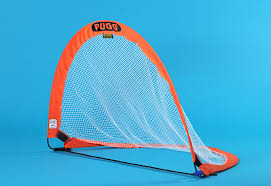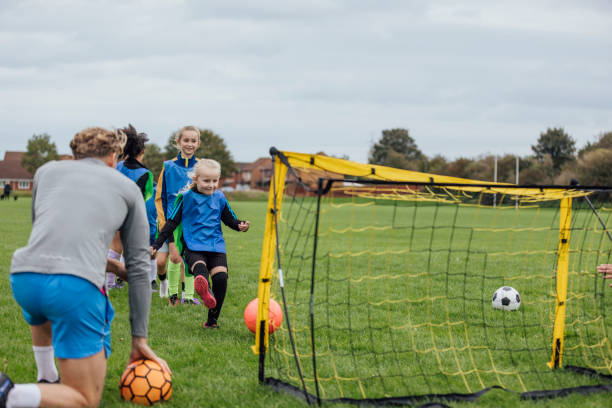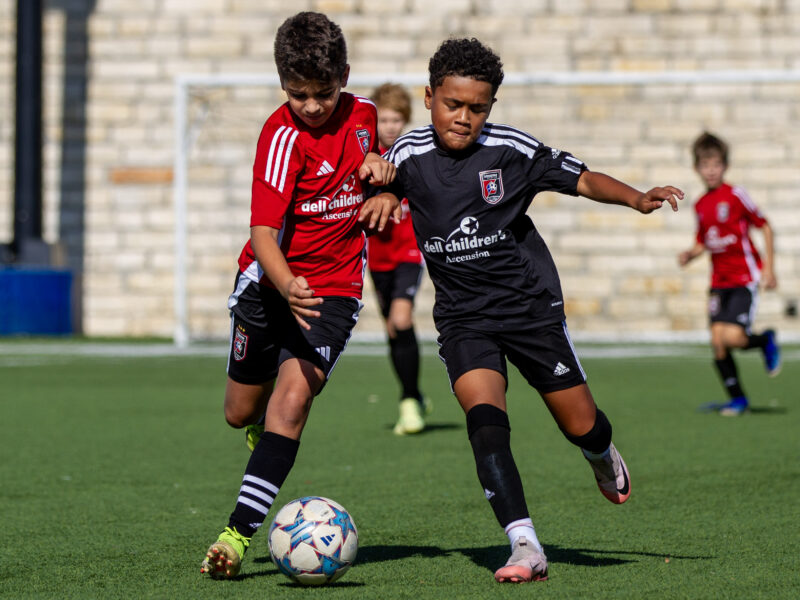Pirate Game soccer drill pulls kids into the moment faster than most drills ever could. From the second you say the name, the energy shifts. They know they’re not about to jog through cone work or stand in line waiting for a turn.
They’re stepping into a game where they have to protect their ball like gold, dodge opponents, chase down loose touches, and fight to stay in the game.
It’s the kind of activity that feels more like a playground battle than a structured drill, but don’t let the fun fool you. Behind the laughs and quick feet, you’ve got players developing some of the most important parts of their game; dribbling in traffic, reading pressure, reacting after mistakes, and thinking two steps ahead.
This drill creates a small world where chaos and focus live side by side. You set the field, you drop the Pugg Goal in the middle, and within seconds, your session is buzzing with movement, intention, and competition.
For 8 to 12-year-olds, it doesn’t get more engaging—or more effective.
Set the Scene

You only need a few things to run this drill smoothly:
- Age Group: 8 to 12
- Players: Minimum of 8 (the more the better)
- Area: A 30×30 yard space
- Duration: Around 15 minutes
- Equipment: Cones for boundaries, 1 Pugg Goal in the middle, soccer balls (at least one for every player except the Pirates), scrimmage vests or pinnies to mark the Pirates
Create a circle using cones. It doesn’t have to be perfectly round, just defined enough for players to know their limits.
Drop the Pugg Goal right in the center of the circle. That’s the target for the Pirates. It represents the treasure chest, whoever steals the ball wants to put it away in the goal to earn their title.
CHECK OUT | How to Run a Perfect 7v7 Soccer Scrimmage for Youth Teams
The Flow of the Drill
Once the players are warmed up and ready, here’s how you roll out the Pirate Game:
- Select 3 players to begin as Pirates. They wear pinnies and do not have a ball.
- The remaining players (ideally 9 or more) each have a ball and start dribbling inside the circle.
- When you give the signal, the Pirates try to steal a ball from any of the dribblers.
- If a Pirate wins the ball, they take it straight to the Pugg Goal and attempt to score.
- If the Pirate scores, the player who lost possession now becomes a Pirate.
- The game continues until only one player remains with a ball. That player is the final winner of the round.
There’s no waiting line, no standing around, no turns to take. Everyone stays active, and the transitions happen naturally. As soon as a player loses the ball, they switch their mindset from attack to defense and join the Pirates.
What It Teaches (Beyond Just Fun)

You can run this drill a dozen times in a season, and each time, the kids will get better at something different. That’s the beauty of the Pirate Game, it teaches in layers.
Dribbling Under Pressure
Players need to keep the ball close. They’re constantly under threat, so big touches or lazy feet won’t cut it. They have to learn control, not just mechanical control, but instinctive, in-the-moment control when someone’s on their back.
Defensive Readiness
As soon as they become Pirates, they become hunters. It forces them to read body language, time their tackles, and pressure without fouling. They learn how to position their body, angle their runs, and stay light on their feet.
Awareness and Decision Making
The best players in this drill aren’t always the fastest or flashiest. They’re the ones who scan constantly. They check space, anticipate where pressure is coming from, and move into safer zones. It sharpens their soccer IQ without needing to pause or lecture.
Mental Recovery
A player loses the ball, it happens to everyone. But now they’ve got a job to do. They’ve got to regroup and switch roles instantly. That teaches resilience and emotional control. It’s one of the most important parts of youth development, and this drill hits it in stride.
Finishing with Composure
When the Pirate wins the ball, they’re not done.
They’ve got to score. That demands a quick shift in mindset and calmness under pressure. It’s a great way to teach finishing after transition moments, something that often decides real games.
CHECK OUT | Fun and Competitive 4v4 Soccer Drill with Small Gates
Coaching Tips That Guide Growth
Your voice matters in this drill. You don’t need to stop it every 10 seconds, but small reminders in the flow can go a long way. Here’s what to keep in mind:
- Tell dribblers to keep their heads up. The more they see, the better decisions they make.
- Emphasize small touches and using both feet.
- Encourage Pirates to close down quickly but with control, they’re not bulldozers.
- Praise quick recoveries and effort after losing the ball.
- Keep the energy high. Your tone sets the vibe. Keep it fun, but focused.
If someone is struggling, pull them aside for 20 seconds and coach them quietly. Let the rest keep going. This keeps momentum and avoids embarrassment.
Tweaks and Variations
As your players get more comfortable, you can start adjusting the drill for more challenge or more variety.
Make It Harder:
- Add more Pirates at the start (4 or 5 instead of 3).
- Shrink the circle to increase traffic and pressure.
- Restrict dribblers to use only one foot or specific surfaces (sole, outside, etc).
Make It Easier:
- Expand the circle to give players more breathing room.
- Allow a second life, if a player loses the ball, they can recover it within 5 seconds before becoming a Pirate.
Add a Twist:
- Introduce “Safe Zones” (small squares marked with cones) where dribblers can pause for 3 seconds.
- Use two goals in the center and let Pirates choose where to score.
- Keep a scoreboard—who steals the most balls, who scores the most goals, who survives the longest.
These changes keep the drill fresh week after week. You can return to it regularly and still find new teaching angles.
CHECK OUT | Youth Soccer Passing Warm-Up Drill for Better Team Play
Suggested Timeline for One Session
Here’s how you might break it down in a single 15-minute block:
- Minute 1–3: Free dribbling inside the circle, no Pirates yet. Focus on control, turning, scanning.
- Minute 4–5: Explain the Pirate Game and rules.
- Minute 6–10: First round of the drill with 3 Pirates.
- Minute 11–12: Quick water break and praise session.
- Minute 13–15: Second round with new Pirates and a slight twist (tighter space, more defenders, etc).
This rhythm allows for learning, repetition, feedback, and excitement, all in a short window.
The Long-Term Benefits
You’ll see immediate fun, but the real value shows up over time. As you revisit this drill week after week, you’ll see more confident players.
They’ll become harder to dispossess. They’ll begin to scan space more naturally. You’ll hear less silence and more communication.
They’ll start to recover faster when they lose the ball.
They’ll play with intent, not just reaction. These are the building blocks of good soccer, and you’re putting them in place with a game they can’t wait to play again.

The Emotional Side of It
Every youth coach knows it’s not just about drills. It’s about how the players feel when they play. The Pirate Game builds that feeling of excitement, of challenge, of involvement.
The timid kid starts to press harder. The skillful kid learns not to rely on tricks. The quiet one gets louder. And the energetic ones burn through their energy in the right way.
You’ve got a drill that builds team spirit, competition, creativity, and effort all with one goal in the middle of a circle.
CHECK OUT | Fun and Competitive 4v4 Soccer Drill with Small Gates
Equipment Recap
Before you head out to run this drill, double-check this short list:
- 1 Pugg Goal (or a small target goal)
- 8–12 soccer balls (one for every non-Pirate)
- Disc cones to form the circle
- Pinnies or vests to mark Pirates
- A whistle or voice to manage the start/stop
- A fun mindset and a bit of imagination
Wrapping Up
The Pirate Game soccer drill belongs in your regular rotation if you’re working with 8–12-year-olds. It’s quick to set up, easy to run, and packed with hidden lessons. Players leave feeling tired, confident, and a little more excited about soccer than they were when they arrived.



